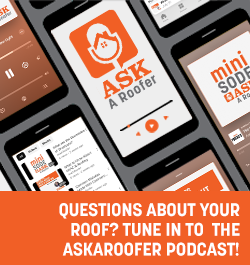A Brief History of Commercial Roofing and Where Roofing Stands Today

By Western Colloid.
From roofs made of beeswax and clay to fluid applied reinforced roofing systems, commercial roofing has had an interesting history!
Commercial roofing has come a long way over the last few centuries. Many advancements have been made to the roofing process, including the cool roofs and fluid applied reinforced roofing (FARR) systems from Western Colloid. But we want to take a trip back in time and look at where commercial roofing started and how far we’ve come today.
Where roofing coatings began
The use of roof coatings dates back to at least 3000 BC in Egypt. There they used coatings made of beeswax, clay, balsam and pitch. Later, in 1000 BC, they made their varnishes from arabic gum. Some of the earliest roofs to exist were made from soil, clay and water mixtures. The roofs would often be waterproofed by pastes made of sand, limestone, gypsum and water.
Formulations of roof coatings began to see advancements in the late 17th century. Chemists in Europe began to develop tar and polymer coatings that are still used in roofing today. One of the more major developments was that of built-up roofing (BUR) in the 19th century. This groundbreaking process came about when it was discovered that hot tar could be layered with felt and covered with gravel to create a solid roof structure. The hot tar was later replaced by asphalt and the felt was replaced by fiberglass mats, creating the more modern version of BUR roofing we know of today.
In the 1960s, companies were developing variations on the BUR concept with different products making up the various layers. This led to the creation of a single sheet that was combined with elastomeric polymers and bitumen to create a modified sheet (modified bitumen) that would be torched and mopped with asphalt, cold adhesive products or even self-adhered.
Along with the creation of modified bitumen came rubber and thermoplastic membranes. These membranes are the polymerized rubber of ethylene propylene diene monomer (EPDM) and the two major types of thermoplastics used in roofing: polyvinyl chloride (PVC) and thermoplastic olefin (TPO). FARR coatings were not far behind.
Roofs of today
We have always loved asphalt roofs because they have the ability to melt a little bit in the heat of the sun and reseal the roof penetrations. Since the hot asphalt is mopped on and flooded on a roof it almost creates a monolithic surface.
Asphalt roofs can be good, but asphalt is often hazardous to work with and has a strong smell. In addition, petroleum asphalt products are much less viable today. The tear resistance and flexible qualities of modified bitumen roofs are great, but this can still involve installing a petroleum product with a torch or mop.
The reflective surface and energy efficiency of TPO roofs is a plus, however, the TPO membrane is also less resistant to chemicals such as grease. It is also prone to cracking. Installation of these roofs vary from ballasted to using a chemical adhesive, also known as adhered or through the use of mechanical fasteners. All seams must be heat welded together so we worry about the problems presented by the many seams that are found on these thermoplastic roofs.
The durability and chemical damage resistant properties of PVC roofs are great. These are also installed using the same methods as TPO, by using ballast, fully adhering the membrane with a chemical adhesive or using mechanical fasteners. But you still get those pesky seams with this type of roof.
EPDM has earned a reputation for weatherability, hail resistance and flexibility. In most cases these types of roofs have a black surface and are adhered with chemical adhesives. But these roofs do not have cool roof properties due to their dark surface.
Most roofs with rolled membranes are at risk of experiencing leaks around the seams, penetrations and ponding water areas. The surfaces of these roofs deteriorate because of the sun and weather, and they also crack, split and oxidize. There is a greater possibility of leaking with rolled membraned products. You can get solar reflectivity with PVC and TPO products, but you still run into the problem of seams and patchwork around the penetrations. There is also deterioration with most membrane products as a result of ponding water, a common occurrence with flat roofs. This leads us to the innovative fluid applied reinforced roofing systems.
What we love about a FARR roof coating system
Take the best parts of all the products being applied today and combine them into one product, and you have fluid applied reinforced roofing. FARR roof coating systems have no seams and therefore offer more security against leaking and ponding water. These systems install easily without any need for rock ballast, chemicals, screws or plates that could potentially penetrate the roof membrane and cause more leakage.
Specifically Western Colloid’s pioneering FARR products also offer energy efficiency, durability and a solid warranty that other roofing systems do not. Plus, if a customer has a failing BUR, Modified Bitumen, EPDM, TPO or PVC roof, they can all be reconditioned with Western Colloid’s fluid applied system. We firmly believe that liquid/fluid applied roof systems are the way of the future.
At Western Colloid, we are committed to producing systems that are environmentally friendly and energy efficient. Our products and systems have the right classifications and approvals that you require and the warranties that you need. Furthermore, we are committed to reducing landfill use by indefinitely extending the life of existing roof systems.
Contact us today to learn more about our company and our well-deserved 50-year-old reputation.
Learn more about Western Colloid in their RoofersCoffeeShop® Directory or visit westerncolloid.com.






















Comments
Leave a Reply
Have an account? Login to leave a comment!
Sign In